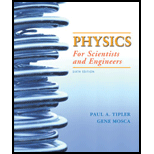
Concept explainers
Whether the force acting or not when the coffee cup sits motionlessly on tray and how it differs from the force when cup is placed on the kitchen table at home.
Explanation of Solution
Introduction:
Newton’s first law of motion defines that an object remains in the state of rest or the state of motion in the same direction unless an external force act upon it.
The forces that are acting on the coffee cup placed over tray are the normal forces exerted by the table on the cup and the gravitational pull of the Earth. The cup placed on the table in the plane is stationary with respect to the surface, as like the cup in the kitchen, which is also stationary with respect to the surface. In both cases, the cup is not accelerating relative to the ground.
Thus, the forces acting upon the cup are the normal forces and the gravitational forces of the Earth. The force on the cup is the same if the table and the cup are in the kitchen as the cup will still be stationary with respect to the ground.
Conclusion:
Therefore, the forces are acting on the cup and they will be same even if the cup is placed on the kitchen table.
Want to see more full solutions like this?
Chapter 4 Solutions
Physics For Scientists And Engineers
- Two children, Raffi and John, sitting on sleds tied together with a massless rope, are being dragged across a frozen river by their playful Siberian husky Rex who is supplying a 112-N horizontal force (Fig. P5.78). The coefficient of friction between the sleds and the ice is 0.08, the combined mass of Raffi and his sled is 42.0 kg, and the combined mass of John and his sled is 51.0 kg. a. Draw a free-body diagram for each of the childsled systems. b. What is the acceleration of the system? c. What is the tension FT in the rope connecting the two sleds? FIGURE P5.78arrow_forwardAn object experiences no acceleration. Which of the following cannot be true for the object? (a) A single force acts on the object. (b) No forces act on the object. (c) Forces act on the object, but the forces cancel.arrow_forwardA 6.0-kg object undergoes an acceleration of 2.0 m/s2. (a) What is the magnitude of the resultant force acting on it? (b) If this same force is applied to a 4.0-kg object, what acceleration is produced?arrow_forward
- A 3.00-kg object undergoes an acceleration given by a=(2.00i+5.00j)m/s2. Find (a) the resultant force acting on the object and (b) the magnitude of the resultant force.arrow_forwardA block of mass m = 5.8 kg is pulled up a = 25 incline as in Figure P4.24 with a force of magnitude F = 32 N. (a) Find the acceleration of the bloc k if the incline is frictionless. (b) Find the acceleration of the block if the coefficient of kinetic friction between the block and incline is 0.10. Figure P4.24arrow_forwardA small sports car collides head-on with a massive truck. The greater impact force (in magnitude) acts on (a) the car, (b) the truck, (c) neither, the force is the same on both. Which vehicle undergoes the greater magnitude acceleration? (d) the car, (e) the truck, (f) the accelerations are the same.arrow_forward
- A large crate of mass m is placed on the back of a truck but not tied down. As the truck accelerates forward with an acceleration a, the crate remains at rest relative to the truck. What force causes the crate to accelerate forward? (a) the normal force (b) the force of gravity (c) the force of friction between the crate and the floor of the truck (d) the ma force (e) none of thesearrow_forwardA 5.00-kg block is placed on top of a 10.0-kg block (Fig. P5.50). A horizontal force of 45.0 N is applied to the 10-kg block, and the 5-kg block is tied to the wall. The coefficient of kinetic friction between all moving surfaces is 0.200. (a) Draw a free-body diagram for each block and identify the action-reaction forces between the blocks. (b) Determine the tension in the string and the magnitude of the acceleration of the 10-kg block. Figure P5.50arrow_forwardA 9.00-kg hanging object is connected by a light, inextensible cord over a light, frictionless pulley to a 5.00-kg block that is sliding on a flat table (Fig. P5.7). Taking the coefficient of kinetic friction as 0.200, find the tension in the string. Figure P5.7arrow_forward
 Principles of Physics: A Calculus-Based TextPhysicsISBN:9781133104261Author:Raymond A. Serway, John W. JewettPublisher:Cengage Learning
Principles of Physics: A Calculus-Based TextPhysicsISBN:9781133104261Author:Raymond A. Serway, John W. JewettPublisher:Cengage Learning College PhysicsPhysicsISBN:9781285737027Author:Raymond A. Serway, Chris VuillePublisher:Cengage Learning
College PhysicsPhysicsISBN:9781285737027Author:Raymond A. Serway, Chris VuillePublisher:Cengage Learning College PhysicsPhysicsISBN:9781305952300Author:Raymond A. Serway, Chris VuillePublisher:Cengage Learning
College PhysicsPhysicsISBN:9781305952300Author:Raymond A. Serway, Chris VuillePublisher:Cengage Learning Physics for Scientists and Engineers with Modern ...PhysicsISBN:9781337553292Author:Raymond A. Serway, John W. JewettPublisher:Cengage Learning
Physics for Scientists and Engineers with Modern ...PhysicsISBN:9781337553292Author:Raymond A. Serway, John W. JewettPublisher:Cengage Learning Glencoe Physics: Principles and Problems, Student...PhysicsISBN:9780078807213Author:Paul W. ZitzewitzPublisher:Glencoe/McGraw-Hill
Glencoe Physics: Principles and Problems, Student...PhysicsISBN:9780078807213Author:Paul W. ZitzewitzPublisher:Glencoe/McGraw-Hill Physics for Scientists and Engineers: Foundations...PhysicsISBN:9781133939146Author:Katz, Debora M.Publisher:Cengage Learning
Physics for Scientists and Engineers: Foundations...PhysicsISBN:9781133939146Author:Katz, Debora M.Publisher:Cengage Learning





